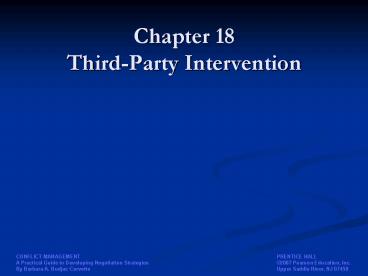Chapter 18 ThirdParty Intervention - PowerPoint PPT Presentation
1 / 22
Title:
Chapter 18 ThirdParty Intervention
Description:
Conciliation the least intrusive. Mediation allows for substantive input from third party. ... Feelers should guard against taking personal affront. PRENTICE HALL ... – PowerPoint PPT presentation
Number of Views:95
Avg rating:3.0/5.0
Title: Chapter 18 ThirdParty Intervention
1
Chapter 18Third-Party Intervention
2
Third-Party Intervention
- Conciliationthe least intrusive.
- Mediationallows for substantive input from third
party. - Arbitrationtakes control out of parties hands.
- Litigationtake control out of parties hands.
- Many courts require arbitration prior to trial.
3
- No downside to using conciliation or mediation
other than the cost. - The worst outcome is another opinion that can be
accepted or rejected. - Parties maintain all control and options.
4
- Labor-management negotiations require observance
of laws and special requirements. - The principles of human behavior applicable to
negotiation generally apply to labor-management
negotiation. - However, certain behavior is illegal, such as
refusing to negotiate on certain subjects.
5
Requisites For Using Third-Parties
- Non-competitive attitude
- Openness
- Potential for negotiation to bring a result
better than your OTNAs
6
- Continue to use your best interpersonal and
persuasive skills with third-party
interventionists. - Competitive or aggressive tactics with
third-party interventionists is not recommended.
7
Skills to Intervene
- Independence
- Credibility
- Top-notch interpersonal skills
- Emotional intelligence
- Unlimited patience
8
Chapter 19Using Your Personal Negotiating Power
9
Using Your Personal Negotiating Power
- The approach most often appropriate is
collaborative. - Temperament affects tactics that may be
successfully employed. - Select tactics that feel natural.
- Select tactics appropriate to the individuals
involved and issues presented.
10
Matching Personality and Temperament to Style
and Tactics
- High need for affiliation, high self-monitoring,
and high emotional intelligence are conducive to
effective collaborative negotiation. - Tact, diplomacy, and good listening are conducive
to effective collaborative negotiation. - The use of distractive tactics likely feels
natural for the harmonizer and action seeker. - Bracketing is likely natural to a pragmatist.
11
Potential Blind Spots
- Extroverts should likely work on listening
skills. - Type As should likely work on developing
patience. - Highly competitive persons should likely work on
being open-minded and seeking common ground. - Thinkers should guard against rigid thinking.
- Feelers should guard against taking personal
affront.
12
Predicting Behavior
- Distractive tactics like diversion and feinting
may work well on harmonizers and action seekers. - Distractive tactics will not work well with
controllers and pragmatists. - Reversal and withdrawal will not be well received
by harmonizers. - Reversal and withdrawal are effective on
pragmatists and controllers.
13
Predicting Behavior (continued)
- Controllers and pragmatists will find it
difficult to accept forbearance. - Controllers and pragmatists are extremely
susceptible to extrapolation. - Pressure tactics may generate destructive
conflict with controllers and pragmatists. - Pressure tactics will likely go unnoticed when
used on harmonizers and action seekers.
14
The Problem Counterpart
- Fractionizebreak the problem into smaller
issues. - Re-framepresent a different perspective.
- Find another ACE.
- Disengage, seek higher authority.
- Assertively confront.
15
Negotiating in Competitive Systems
- The best way to persuade is through
collaborationeven in competitive systems. - Aggression and manipulation are not
collaborative.
16
Negotiating in Avoidant Systems
- COLLABORATION!
17
Chapter 20Post-Negotiation Evaluation
18
Indicia of Successful Negotiation
- Both sides feel successful.
- Both sides are able to and intend to honor the
agreement. - In cases where no agreement was reached, both
sides feel that the failure was the result of
issues and not the unreasonableness of or tactics
used by the other party. - No party bears personal animosity toward another
party. - No party fears any negative repercussion from the
others. - Each side is amenable to dealing with the other
in the future.
19
Post-Negotiation Evaluation
- If no agreement was reached, was the decision to
terminate appropriate? - Did you effectively adapt to new information?
- Do you have an option that is better than what
you left on the table? - Did negotiations terminate due to substantive
impasse? - Did negotiations terminate due to personality or
communication difficulties?
20
Post-Negotiation Evaluation (continued)
- Were you adequately prepared?
- Did you use tactics that were comfortable for
you? - Did the tactics work well for you?
- Did you react appropriately to tactics used by
your counterparts? - What types of power did you use?
- Did you react appropriately to power used by your
counterparts?
21
- After each negotiation you should also ask
- Could I have done any better?
- What did I learn about myself and about
negotiation? - What would I do differently if I could repeat
this negotiation?
22
Personal Excellence Progress
- Evaluate your PEP after each negotiation.
- Effective negotiation skills require attention
and practice.































